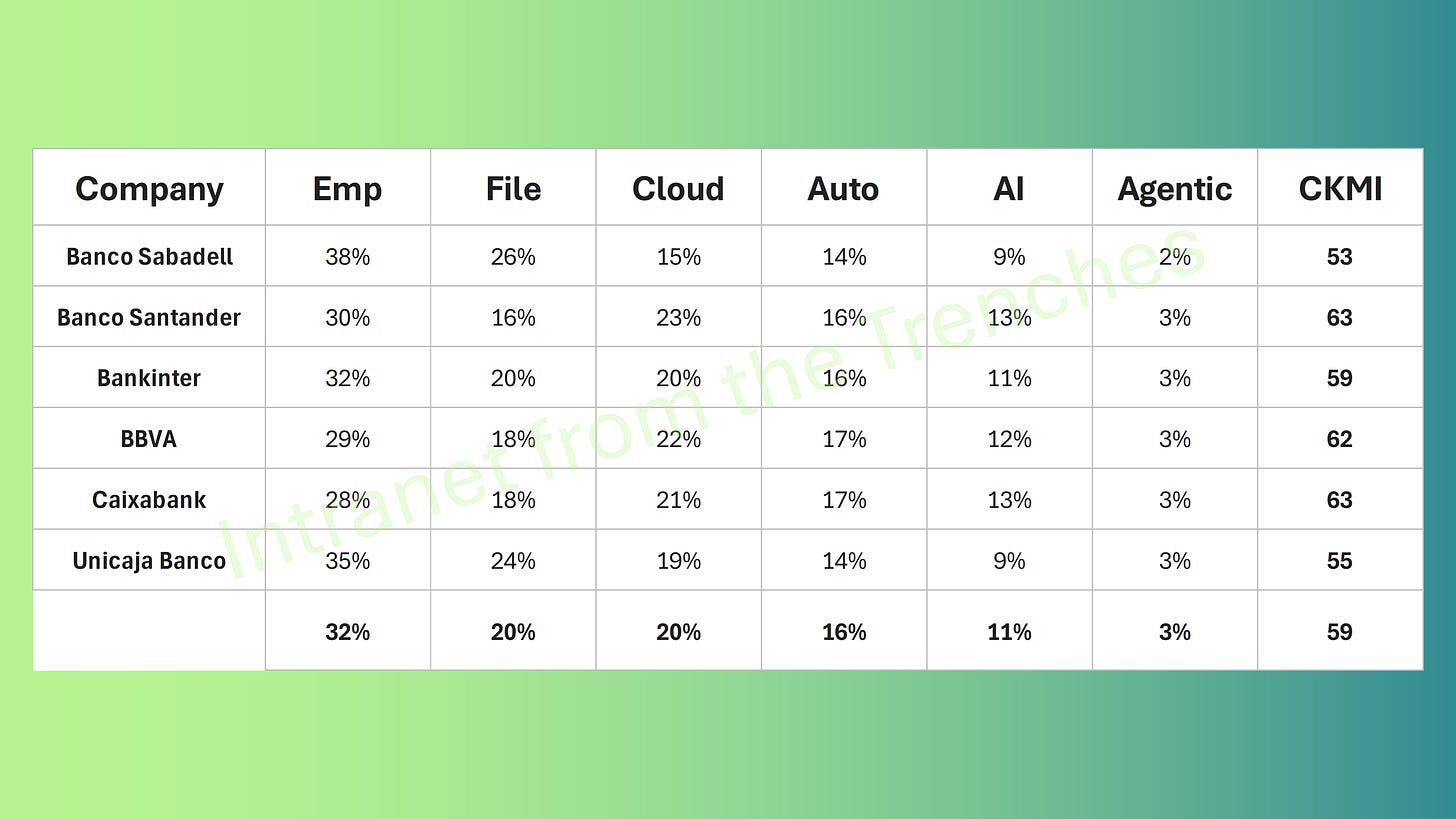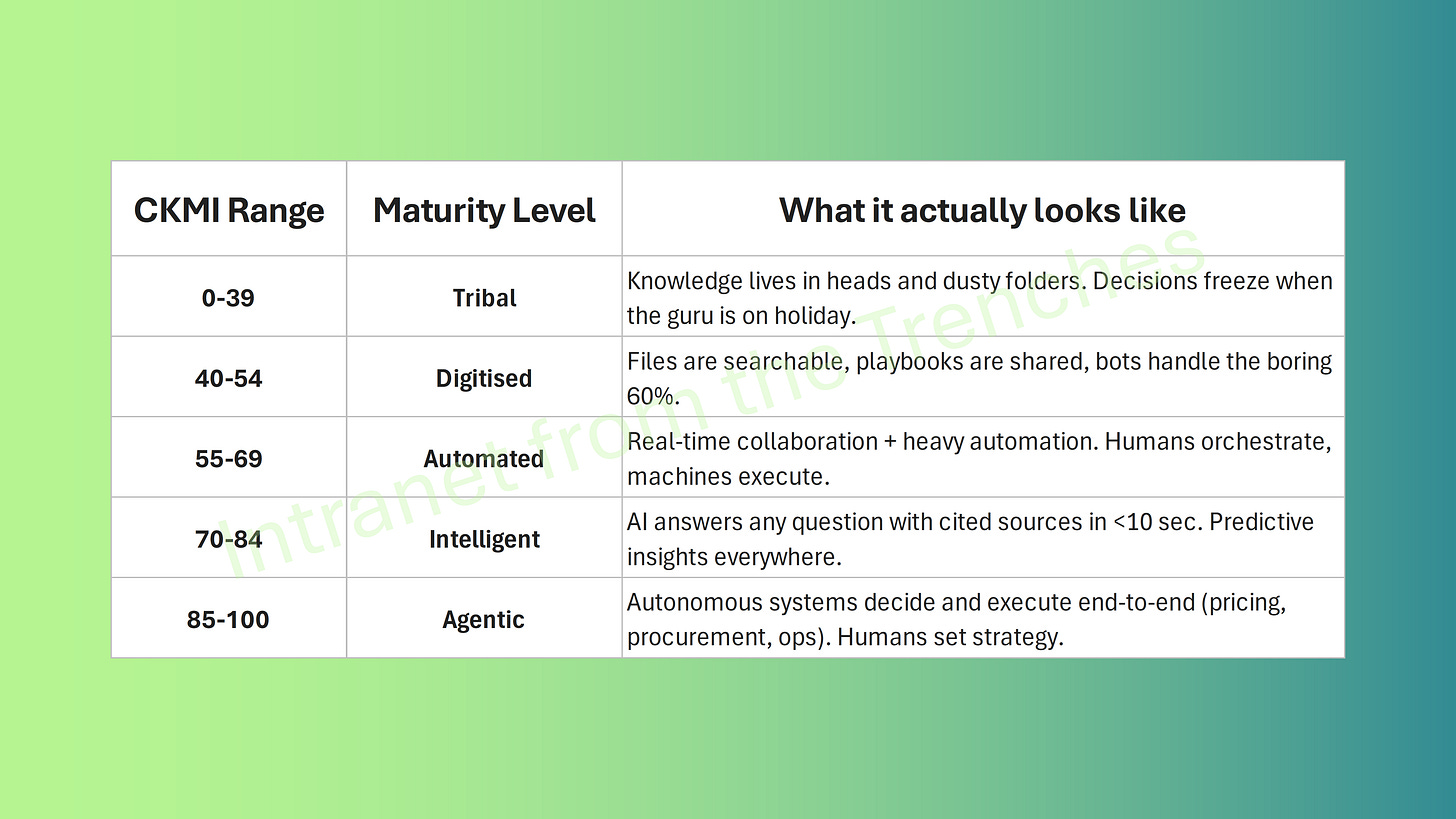The Knowledge Management Maturity Index
Imagine a five-minute game that exposes exactly where your company’s knowledge lives: you distribute 100 points across six buckets and the pattern instantly reveals whether you’re stuck in human silos or running on autonomous agents. No surveys, no NDAs—just a mirror.
This post turns that game into a public experiment on the IBEX 35. Using the same simple 100‑point allocation and four LLMs (GPT, Grok, Gemini, and Mistral) interpreting public data such as 2025 earnings calls and CNMV filings, I’ve built a sector heatmap, a CKMI quick self‑assessment, and a practical way to understand where knowledge actually lives inside large Spanish organizations. Everything you see here comes from public signals—no surveys, no internal data.
The 6 Buckets: Your Knowledge DNA
Think of your company as a living organism, pulsing with information that keeps it alive and competitive. Its “knowledge DNA” isn’t stored in one place—it’s spread across six interconnected tissues, each handling information differently, from fragile human insight to autonomous execution.
1. Employees - The Neural Tissue
Knowledge that lives only in human brains: tacit expertise, intuition, and tribal know‑how. This is the trader who “feels” a shift before the charts move or the engineer who knows which component fails under stress. It’s powerful but fragile—when people leave, 20–30% of their operational knowledge disappears with them.
2. File Servers - The Skeletal Archive
The rigid bones of the organization: static documents, PDFs, spreadsheets, and old source code buried in NAS drives or shared folders. Essential for compliance and historical reference, but inert and difficult to search. Without indexing or cloud migration, they become vaults instead of living assets.
3. Cloud Tools - The Circulatory System
This is where knowledge flows—real-time collaboration, shared dashboards, and co‑edited documents. Cloud tools keep information accessible and alive, powering daily decisions. But scale brings risk: version sprawl, duplicated spaces, and shadow IT.
4. Automation - The Muscular Reflex
Scripted workflows that execute repeatable tasks: RPA, CI/CD pipelines, batch jobs, and process triggers. They remove friction and stabilize operations, but they are brittle—when APIs change or business rules evolve, they snap.
5. AI - The Sensory Cortex
Systems that understand, summarize, and detect patterns. Think internal chatbots that cite policy documents or RAG systems answering regulatory questions. AI reduces decision latency dramatically, but its quality depends entirely on the data feeding it.
6. Agentic – The Autonomic Nervous System
Autonomous multi-agent systems that decide and act without waiting for human prompts. Procurement bots, grid-optimization agents, autonomous scheduling. This is the far right of the maturity curve—and most organizations today sit at 0%.
The Exact LLM Prompt
Now that you understand the six buckets, here’s how to generate objective scores using LLMs—the same method used for the IBEX banking analysis below.
To smooth out model quirks and capture a balanced view, I ran the prompt through four frontier LLMs: GPT, Grok, Gemini, and Mistral. This gives a mix of real‑time browsing, financial reasoning, and open‑weight transparency. Outputs were averaged using a simple mean.
Note: This method interprets public signals, not internal KPIs. It’s an external diagnostic, not an audit.
Additional note: Some LLMs occasionally return allocations that don’t add up to exactly 100%.
Here is the copy-paste prompt—swap [COMPANY_NAME] and hit enter:
You are a knowledge-management analyst.
Take the company [COMPANY_NAME] and distribute 100% of its organizational knowledge across the six buckets below.
Base every percentage and justification ONLY on public information available up to today (earnings calls, CNMV filings, annual reports, press releases).
Buckets (use these exact definitions):
1. Employees – tacit expertise that exists only in people’s heads (e.g., trader intuition, engineer heuristics).
2. File Servers – static documents or code stored on on-premise servers (e.g., PDFs, NAS folders).
3. Cloud Tools – real-time collaborative platforms (e.g., SharePoint, Google Workspace, Notion).
4. Automation – scripted, repeatable workflows (e.g., RPA bots, CI/CD pipelines).
5. AI – semantic search, summarization, or RAG tools (e.g., internal chatbots that cite sources).
6. Agentic – autonomous multi-agent systems that make and execute decisions (e.g., procurement or grid-optimization agents).
The Company Knowledge Maturity Index (CKMI) calculation (apply automatically):
1. Foundational = Min(Emp + File + Cloud, 60)
2. FoundationalIndex = Foundational / 3
3. CKMI = (FoundationalIndex + Auto + AI + Agentic) / 80 * 100
Round CKMI to nearest integer; cap at 100.
Output exactly one line in this format:
[COMPANY] | Emp XX% | [1 public-source sentence] | File XX% | [1 sentence] | Cloud XX% | [1 sentence] | Auto XX% | [1 sentence] | AI XX% | [1 sentence] | Agentic XX% | [1 sentence] | CKMI: XX
What you get back is a single atomic line: six percentages (sum 100%), six public-source justifications, and one CKMI score.
The Company Knowledge Maturity Index (CKMI)
Your 100-point allocation across the six buckets isn’t just a snapshot—it’s the raw material for a simple, transparent diagnostic. The CKMI is intentionally designed to be easy to understand and verify. Below is the full formula explained step by step—no magic, no black boxes.
How the formula works — clearly and line by line
Foundational = Min(Emp + File + Cloud, 60)
Add your three foundational buckets (Employees + File Servers + Cloud), but cap the result at 60. Even if a company has 80–90% of its knowledge in legacy sources, it can’t earn more than 60 here. This prevents over-rewarding silos.FoundationalIndex = Foundational / 3
Divide the capped score by 3. This converts the maximum foundational contribution into 20 points (the absolute most legacy systems can contribute to maturity).CKMI = (FoundationalIndex + Auto + AI + Agentic) / 80 × 100
Add your advanced buckets directly—Automation, AI, and Agentic—then add the foundational index. The maximum possible total is 80, so dividing by 80 and multiplying by 100 scales everything to a clean 0–100 index.Round to the nearest integer and cap at 100.
Each 10-point jump represents a tangible leap in resilience, operational speed, and your organization’s ability to make decisions without constant human intervention.
Let’s Put This into Practice
Now that the model is clear, let’s apply it to a real sector. Below is the heatmap extracted from Spain’s six largest listed banks, using only public information and averaged across GPT, Grok, Gemini, and Mistral.
As part of a transparency exercise, all raw model outputs, intermediate values, normalizations, and the averaging spreadsheet are published here: link
This lets anyone reproduce the scores, recalculate the CKMI, or run their own interpretation of the buckets.
What the numbers actually say
Instead of reading them as isolated percentages, think of these as knowledge-weight signals—where each bank concentrates its operational intelligence.
Employees (28–38%) — Human expertise still carries most of the load. Even the most digital banks haven’t escaped intuition‑driven work.
File Servers (16–26%) — Legacy repositories are shrinking but remain part of daily operations.
Cloud (15–23%) — Modern collaboration is widespread; knowledge flows more freely than before.
Automation (14–17%) — Automated workflows are now standard hygiene, not competitive advantage.
AI (9–13%) — This is where differentiation begins. Santander and Caixabank push ahead; Sabadell and Unicaja lag.
Agentic (2–3%) — Still embryonic. No bank has crossed the threshold into autonomous decision systems.
Together, these patterns create a CKMI spread from 53 to 63, a narrow but meaningful difference that separates digital laggards from digital leaders, only 10 points between laggard and leader.
Where Do You Stand? The CKMI Maturity Ladder
The CKMI isn’t just a score—it’s a simple classification system that shows where your knowledge organism sits today.
Using the exact CKMI values from the Spanish banks:
Banco Sabadell (53) → Digitised: Heavy reliance on people; AI and automation gaps.
Unicaja Banco (56) → Automated: Momentum growing; still early in advanced capabilities.
Bankinter (60) → Automated: Strong foundation; poised for a significant AI step-up.
BBVA (61) → Automated: Balanced capabilities; one agentic pilot away from Intelligent.
Santander (63) → Automated: Leading in AI adoption; competitive edge emerging.
Caixabank (63) → Automated: Matching Santander; strong rightward shift.
Sector Average (59) → Automated: The tribal era is fading, but no bank is intelligent yet.
Your Turn
If you want to understand where your own company stands, play the same 100‑point game:
Distribute 100 points across the six buckets.
Apply the CKMI formula step by step.
Compare your score with the Spanish banks above.
You’ll instantly see whether you operate more like Sabadell, Santander, or somewhere in between—and which bucket is your biggest opportunity for improvement.
Conclusion
The six-bucket game and the CKMI model reveal a simple truth: maturity isn’t about how much knowledge your company holds—it’s about how little you rely on any single person to use it. Every 10-point shift to the right (from Employees toward Agentic) cuts decision latency, reduces key-person risk, and frees people to focus on strategy instead of searching for information.
You now have everything you need: a knowledge classification, a transparent formula, real sector benchmarks, and a clear maturity ladder. Run the game for your team—or your entire organization—and calculate your CKMI. Then:
Share your score in the comments,
Compare it with the Spanish banks’ results,
And tell me which bucket surprised you the most.
Let’s turn this into a collective experiment. Your insights can help others understand where their knowledge really lives—and how to shift it rightward.
References
ChatGPT: https://chatgpt.com/
Gemini: https://gemini.google.com/
Grok: https://grok.com
Mistral: https://chat.mistral.ai/chat





